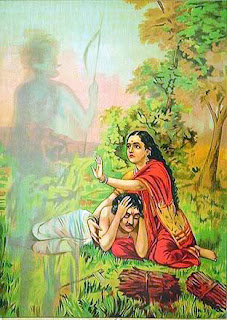Savitri, The Indian Alcestis

Savitri / Image Credit Savitri was a legendry princess in Hinduism, renowned for the love she had for her husband. She was the daughter of the king of Madra, Ashvapati, and his wife Malati. As Savitri was very beautiful and radiant, this deterred prospective suitors from approaching her father and asking for her hands in marriage. As a result Ashvapati asked his daughter to choose a person of her liking so that he could fulfill his obligation to marry her off. Hence, Savitri set out to tour the country in her golden chariot in search of a suitable mate. She went though forests and cities, until she found Satyavant, son of Dyumatsena, the blind King of Shalwa, then in exile, living in poverty. As luck would have it, Satyavant was destined to die after one year from the marriage date. Savitri followed him when he was being carried away by the death-god Yama, and so impressed the god with her loyalty that he released her husband.




